Live 10’s New Effects: A Look Behind the Scenes
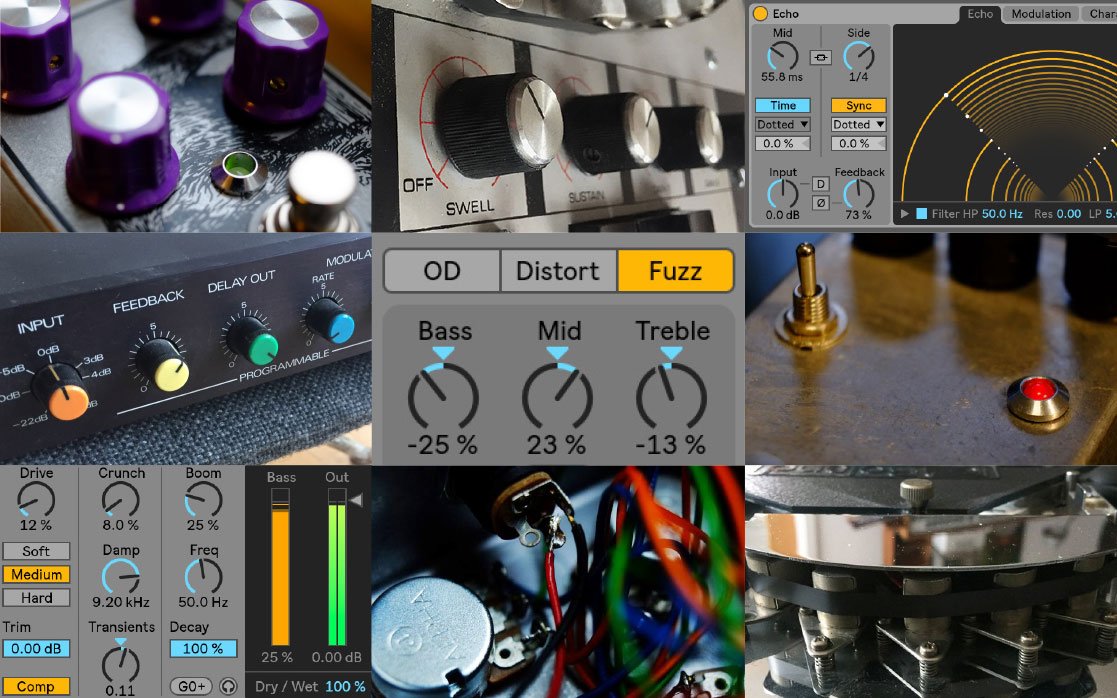
“It was kind of a fluke” admits software developer, Marc Résibois, about the conception of Live 10’s new Drum Buss device. “I had this code for a filter that I’d been playing with for a while; I really liked the way it sounded. I was just messing about with it and inverted the filter from high to low pass – it suddenly started booming in a really satisfying way. I was pretty sure it was something worth exploring.”
The happy accident that led to the Drum Buss prototype sounds a lot like the kind of creative spark that leads to a new track. But surely serendipity isn’t the only force behind Live’s new creative tools? Asked to tell us more, the Live development team let us in on the inspiration and perspiration behind three characterful new audio effects for Live. They also passed on some insider’s tips on how to use the effects in your music.
Sparks and sprints
Following its unforseen invention, an early version of the Drum Buss device was soon on show at one of the development team’s regular hack sprints – a kind of internal show-and-tell used for Live experiments – where it picked up admiration from fellow engineers. “People are encouraged to explore whatever they want,” says device designer Matt Jackson, who had a hand in the production of Drum Buss, Wavetable (Live 10’s new synth), and Pedal – a device that took off from the same hack platform. “With Pedal, there wasn’t a formal decision by a project owner to develop it. The early form of the device we saw at a Sprint was so convincing that everyone quickly got behind the idea.”
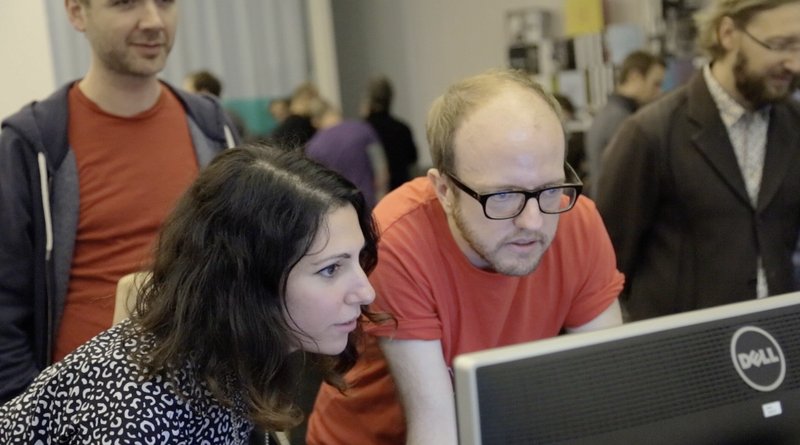
Audio experimentation at a hack sprint
The origins of Echo, Live’s third new audio effect, were a little more predetermined. “We felt a slight dissatisfaction that we didn’t have any modulated delays in Live” reveals the Sound Team’s Christian Kleine. “Our existing delay effects are quite clinical – we wanted something that could drift a little more. And delays in themselves are so powerful. A lot of effects are based on them: flanger, chorus, even reverb to a degree.” Christian saw a chance to create new effects that would broaden Live’s palette: “They distort sound in a way that is usually only known in analog gear. Precise effects have their own charm, but Live’s new ones mean you create more sounds that just don’t sound like computer music.”
Inspiration over emulation
Christian led the research into the world of classic hardware delay units that guided Echo’s initial design.“We made a kind of playlist of songs with delay sounds we found interesting; ones that would have been hard to achieve with what we had in Live. Then we recorded a whole bunch of old delay and echo units – like the Roland Space Echo, WEM Copicat and Morley Oil Can – and asked ourselves, What gives them their character? What are the quirks and imperfections that make them interesting, and how might we go about recreating these?”
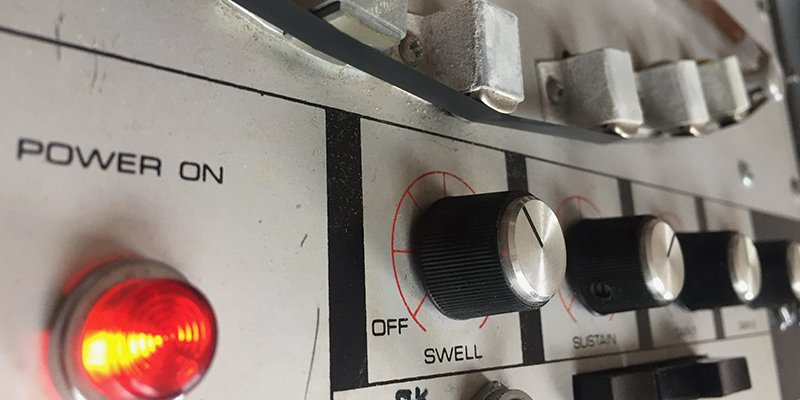
Taking inspiration from classic delay units
With the idiosyncrasies of these devices in mind, software engineer Marco Fink worked under the hood of both Echo and Pedal: “To emulate the repitch behaviour [that results when changing the delay time] of many hardware delay units, for example, you have to think about the physics of what's happening in the hardware. And then you reproduce it digitally with a mathematical model.” But aside from Echo’s analog-modeled filters – which Marco mentions “distort, compress and saturate” – the effect is no copycat. “It was never our intention to model anything real” explains Christian. “It was more about capturing the spirit of these things; covering similar sonic space.”
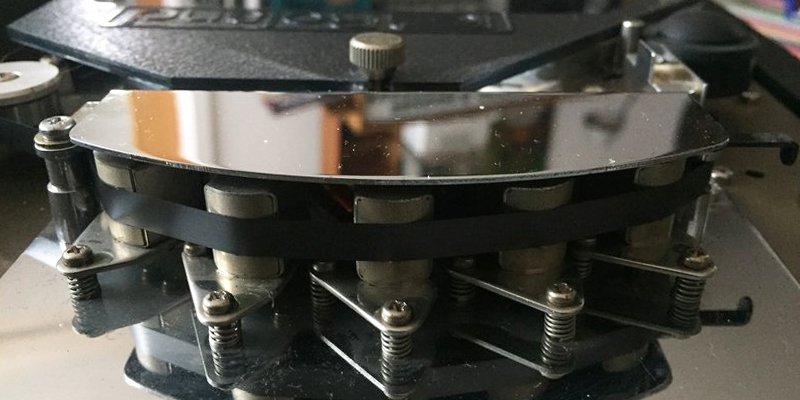
The behavior of tape components brings distinctive sonic characteristics
While Drum Buss wasn’t directly influenced by specific pieces of gear, its conceptor Marc always imagined it as “A hardware device that never existed” on account of its immediate, limited control set. With Echo and Pedal, however, it was a case of concrete inspiration from hardware. Matt echoes Christian’s words about character and spirit: “I think what’s interesting is that we actually didn’t emulate a specific pedal. We listened to a variety of classic stomp boxes and tried to combine the different characteristics and elements in a way that worked harmoniously. We tried to get the essence of the pedals.”
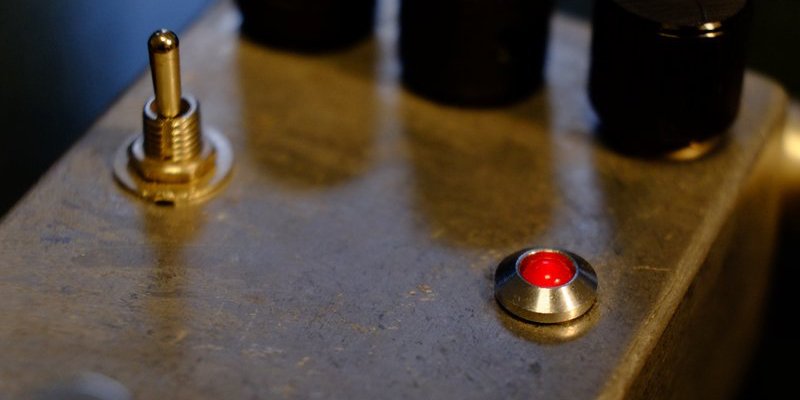
Capturing the essence of hardware pedals
But how do you go about capturing this hardware spirit? What’s the ghost in the machine? Christian uses the example of Echo: “Its LFO behaves perfectly; digitally. But as soon as you introduce something imperfect, that behaves randomly in a listenable way, you perceive it as more alive. More analog. Sometimes it’s fairly simple to introduce artificial randomness, but in other cases it’s very challenging. We spent a lot of time experimenting with how to best achieve nice-sounding noise and wobble, for example.”
Finding the balance
Pedal was also inspired by the characterful way hardware components process sound. “But we also wanted it to be efficient”, Marco points out. Herein lies a new challenge. Engineers often face the question of how deep to go when emulating analog behaviour. Especially when processing in real-time, replicating the finer details demands more and more CPU. “You have to choose between simple and more sophisticated models for every part of the device”, adds Marco.
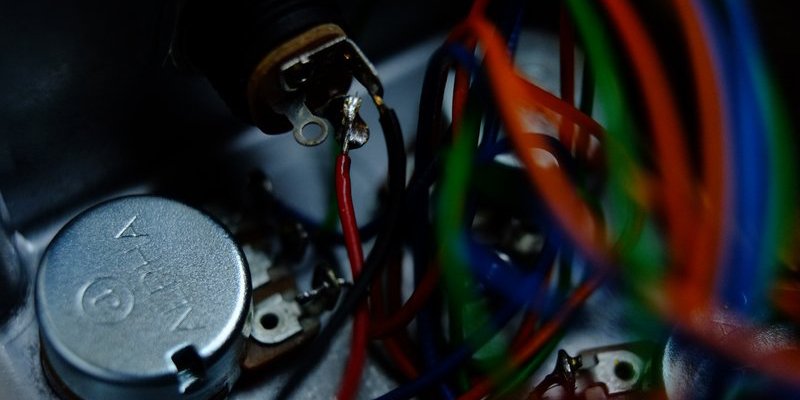
Under the hood: understanding analog processing
A different usability issue informed the development of Echo. Christian explains how original designs were for a simpler device: “In the beginning we wanted to create something with very few parameters – we always think about how to avoid adding more features. But many early user-testers wanted access to what's behind those controls, so we decided to expose quite a few of them, like the noisy elements for example."
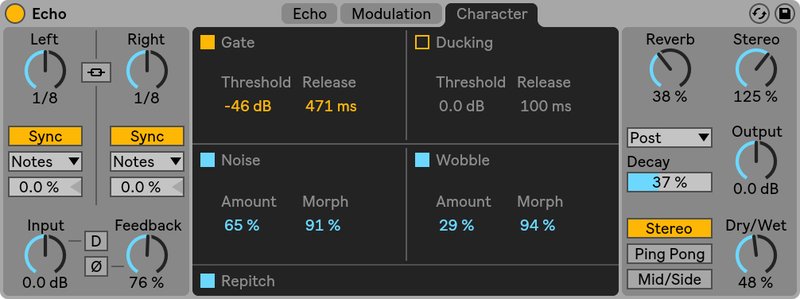
Noise and wobble parameters in Echo offer control over pitch inconsistencies and noisy artefacts
"This makes Echo a little more complicated at first use, but also better for creating unique sounds. You’re always walking a line between usability and breadth of options. We still have tons of ideas for what we could add to Echo, but if we put them all in, the thing would explode! Prioritizing which functions to include needs testing with others, listening and making music with it.”
There were other balances to get right. The handful of parameters in the Drum Buss device, Marc explains, needed careful calibration: “We had the Boom section in place, then after some initial user testing we added crunch and later transient shaping, compression and other elements. We wanted a device with few parameters that would all play really nicely together, so they sound like something desirable no matter what you do. So we spent a lot of time tweaking – probably 75% of the time was spent finding the right balance between the various processing elements.”
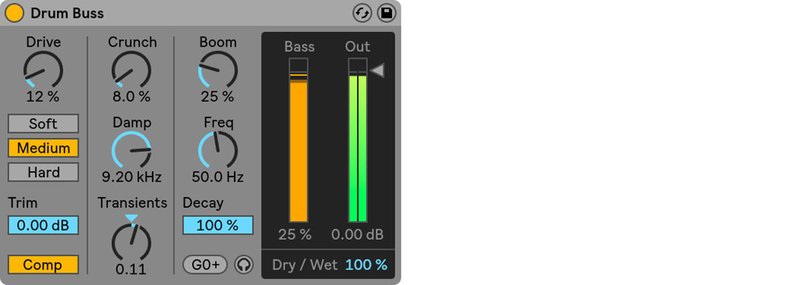
A fine balance between Drum Buss’ elements means a broad sweet spot of desirable sound
Testing and teamwork
User testing can play a big part in the creative decision-making process. Marc is clear about the importance of other music-makers in the development of the Drum Buss: “It was super useful as it helped us make decisions about what to do next. It gave us a lot of direction.” The Pedal device underwent a lot of tone-tweaking; it was made to sound more extreme, especially after user feedback that suggested the Fuzz sounded “A bit too nice”.
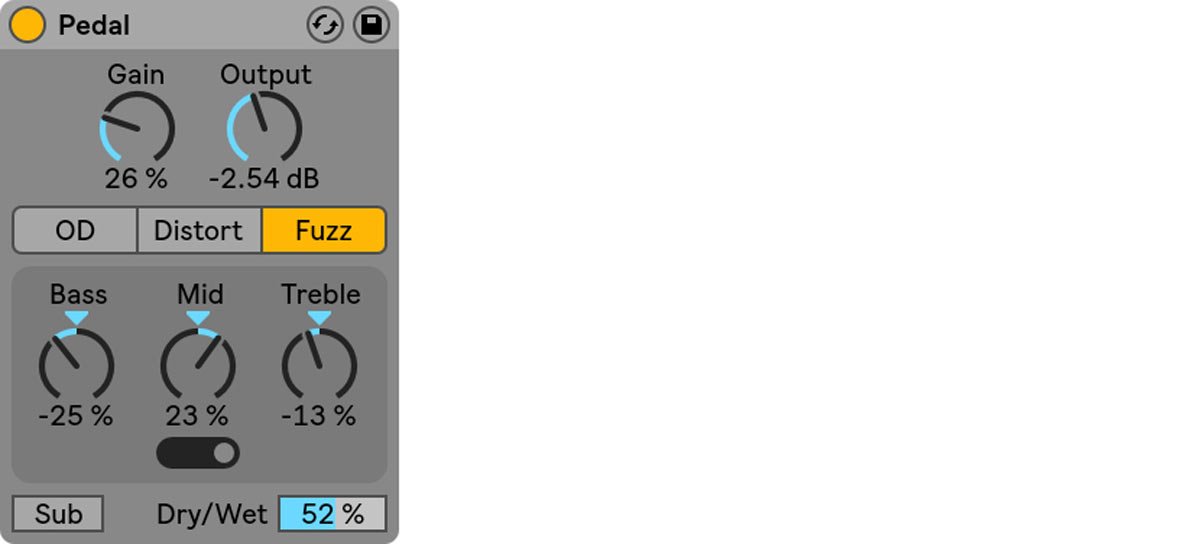
Following user testing, Pedal’s Fuzz mode got some not-so-nice tone-tweaking
Echo grew a Mid/Side mode quite late in the process after early feedback from music makers – “We thought about about it, tried it and it was so interesting, we had to do it”, Christian enthuses.
But what is Mid/Side? "Instead of processing the left and right channel of a stereo signal, Echo delays the sum and difference of the channels individually", explains Marco. "The mono and stereo part of a signal can be repeated using different delay times to create a time-variant stereo image – so you can have, for example, fast repetitions in the centre, but slower ones on the sides. Sonically it really does have its own character."
Synth bass processed with Echo’s Mid/Side mode
Though the teams behind the three effects were small, they nonetheless fostered divergent points of view. “Typically there’s one lead person who has an idea or vision, then a few others doing development and design”, says Christian. “But what I found interesting about the process for Echo is the different perspectives. Coming from a musician's background, I had a clear idea of what I wanted things to sound like. An engineer might not have the same vision, but a better technical perspective. If something is technically crappy but still sounds great, to me that’s wonderful! But not for an engineer… you still have to make it usable. So that makes for some interesting discussions.”
Working on Drum Buss, Marc shared this preoccupation with sound, and reliance on the rest of the team: “I have a very experimental approach to things. I’m just trying to discover things that sound cool rather than making sure I’m doing it the best way. I usually end up with code that has 'spirit' but doesn't behave very elegantly – I often make mistakes. Fortunately I have team members with a deeper understanding of intricate DSP matters than me.”
For Marc, working in such small teams can help a device inherit real character and uniqueness. “I think it’s nice when something like this is built by a small team. It’s easier to reflect someone’s personality. Drum Buss is not a neutral device. It has a colour; a way of working. It makes sounds the way I like them!”
Using the devices
So what do the new effects sound like? What makes them special, and how can you make music with them? The devices’ creators gave us some tips, and came up with some audio examples to demonstrate them.
Pedal
Pedal “Completes the circle” of devices for guitars in Live. It helps to get more sounds out of Amp and Cabinet, bringing the kind of extreme saturation made famous by a long list of guitarists, dating back to the 60s, topped by the likes of Jimi Hendrix and Led Zeppelin. It’s a sound that the latter band’s guitarist, Jimmy Page, described as outright “rude”.
A dry riff, then with Pedal's Fuzz, Overdrive, Distortion, and finally a Pedal-Amp-Cabinet Rack
Using on synths will also deliver extreme results. Think of the wailing distortion employed by Daft Punk at an earlier, rawer point in their oeuvre:
“One unconventional use,” adds Matt, “is to sweep EQ peaks around before a Pedal device – the results are really unexpected. It sounds more like a change in distortion type than a filter sweep. And don’t worry about the resonance – just go completely nuts!”
Some EQ Eight sweeps before Pedal in Fuzz mode (plus beat processed with Drum Buss)
“It can certainly do more heavy-handed distortion sounds,” Marco adds, “but with the Wet/Dry control you can of course be subtle too. Some people even use this type of effect on vocals to add a bit of brilliance; like an exciter. They stack a second distorted voice on top of the clean one.”
Echo
So aside from tape delays and the psychedelic stereo panorama of Mid/Side mode, what sounds are possible with Echo? (You can download the preset files of the settings used to create the following audio clips.)
“Well, you can combine cleaner digital sounds with analog noise in useful ways”, Marco explains. “You can have something with the wobble and noise of a tape delay, but not the darkness or compression. Or, have a tape-like distortion without the noisy artefacts. Of course in the analog world, you can’t separate these.”
“The way you can modulate things goes way beyond what you could do in any of the hardware pieces [whose sound inspired Echo]”, says Christian. “It’s quite simple to achieve really nice flanging, chorus, and other pretty weird sounds. It’s just a fun device – you can happily play with the feedback for 10 minutes if you want”. Marco adds, “I like the weird robotic sounds you can get by setting small delay times, adding lots of feedback and modulating the time with a Random LFO setting."
"It’s also really good to use with a guitar, especially if you’re into ambient or drone music. The kind of interconnecting delays and reverb combos you need are built into Echo. Just set the reverb to Feedback mode with a long decay time”. “Shoegazing made simple!”, adds Christian.
“It also has an envelope follower," continues Christian, "which responds to the amplitude of the input signal. Using a guitar, the amplitude of the note can be used as modulator for the delay line. It’s a very organic feature to have. You can do envelope-followed flanging or delay lines and this sort of stuff. People like Frank Zappa used it quite a lot.”
An enveloped-flanged delay – first with guitar, then a drum loop
Drum Buss
“The thing I like most about Drum Buss is that it finds a nice balance between instant gratification and control,” says Marc. “When you add the device, your drums just sound bigger right away. Then you can tailor things to how you like them – boomy lows, crunchier highs, snappier attack. It's definitely rooted in the distorted drum-machine beats of contemporary hip-hop, and harsher drum sounds in rock/electronic crossovers.”
“But you can get very subtle with it too; it’s not just about in-your-face sounds. People have started using it for kicks, snares, single percussion elements or even synths – all with very convincing results that don't necessarily carry any Drum Buss imprint. For me, that’s a reflection of its versatility.”
An acoustic kit processed with Drum Buss – from subtle to heavy treatment.
“So yeah, it was made for buses, but like with a good hardware unit, you should feel free to abuse it on anything!”.
Drum Buss is part of Live 10 Standard and Suite. Pedal and Echo are included with Live 10 Suite. Compare editions of Live 10.
Want to stay up to date with us?
For more news, blog posts and videos, sign up for the Ableton Newsletter.